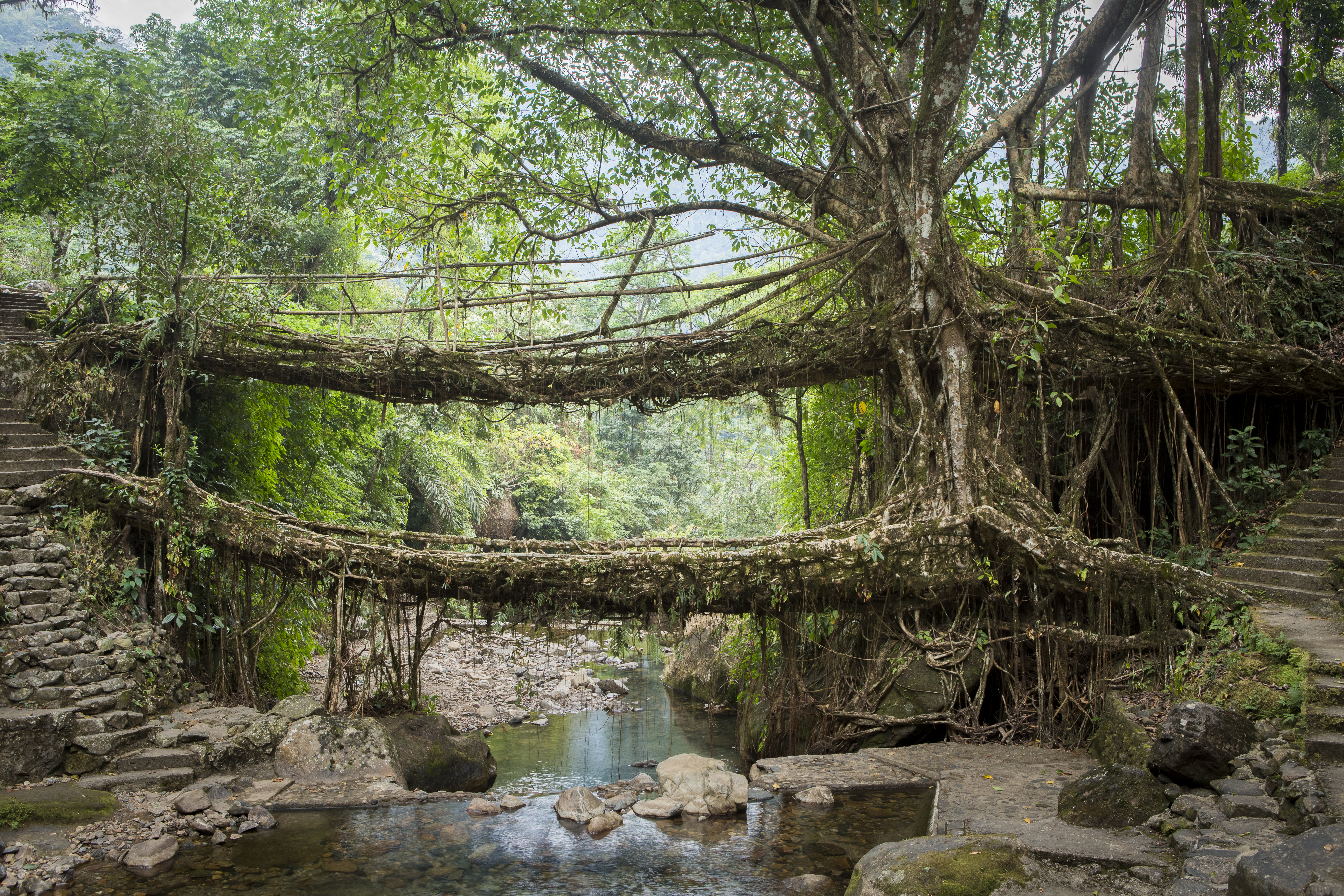- The state of Meghalaya in northeastern India is home to the two towns with the highest annual rainfall on Earth.
- Historically, India’s monsoon season brought heavy storms and floods, leading man-made bridges to rot and decay.
- To survive these conditions, Meghalaya’s indigenous Khasi people made bridges out of a tree commonly known as the Indian rubber plant.
- Ficus elastica, a species in the fig genus, has aerated roots that can be tied, twisted, and shaped into bridge-like structures.
- Meghalaya’s living root bridges, a few of which are estimated to be over 500 years old, attract tourists from all over the world.
In the wettest place in the world, you won’t cross bridges that were built. You’ll cross bridges that were grown.
Located in northeast India along the border of Bangladesh, the state of Meghalaya is home to the two towns with the highest annual rainfall on Earth, according to Guinness World Records.
The village of Mawsynram tops the list with 467 inches, or nearly 39 feet, or rain per year, followed closely by the town of Cherrapunji, which gets 463 inches of rain every year.
The indigenous Khasi people in the region have relied on their ingenuity to survive in these conditions. Root bridges are one example of that ingenuity.

The origin of living root bridges in Meghalaya
During monsoon season in India, which lasts from June to September, rivers in Meghalaya flood, leaving local communities stranded. Historically, the Khasi people built bridges out of bamboo to get around, according to the BBC. But their man-made structures were unable to withstand rough storms and would quickly decay.
So, the Khasi people turned to a tree commonly known as the Indian rubber plant or Indian rubber fig. Ficus elastica, a species in the fig genus, has aerated roots that can be tied, twisted, and shaped into bridge-like structures.
But the process of growing a living root bridge is neither short nor simple. It takes 10 to 30 years before the tree's roots resemble a bridge. Once the bridge is formed, however, it can live for centuries and be sturdy enough to hold upwards of 35 people at once, according to National Geographic.

Traditionally, the Khasi people start the process by planting a tree on each side of a riverbank. Then, they thread and twist the tree's roots around a makeshift wooden bridge, which helps guide the roots to the other side of the river. When the roots are long enough to reach the other riverbank, they plant down into the ground. Over time, the roots grow and strengthen, making the bridge stronger.
While no one knows when the first living root bridge was created, written records of the structures appear as early as over 100 years ago, according to National Geographic.
Read more: 7 mind-bending bridges in Asia that will make you look twice
Trek to the iconic Double-Decker root bridge
There are dozens of root bridges scattered across northern India, but the Umshiang Double-Decker root bridge in Nongriat village is arguably the most recognizable.
Also known as the Jingkieng Nongriat, this structure features two suspension bridges stacked on top of each other. The bridges are built across the Umshiang River, and they attract tourists from around the world.

But the trek to the Umshiang Double-Decker root bridge is no joke. Hikers must be ready to embark on a strenuous 3,000-step journey into the lush valleys of Nongriat.
Along the way, tourists cross rivers, waterfalls, and wildlife, as well as several other root bridges. One of these bridges is the Ummunoi root bridge, which is considered the oldest living bridge of its kind in the region, according to Indian Holiday Pvt. Ltd, a New Delhi-based travel agency.
Nilisha Mohapatra and Adam Rosendahl are two of the many visitors who have hiked to the Umshiang Double-Decker living root bridge. Speaking to INSIDER, Mohapatra said the Ummunoi root bridge was the "coolest thing [she's] seen."

While it may not be easy, the trek is all worth it once you reach the final destination. There, you'll find the Double-Decker root bridge surrounded by thriving greenery and a rushing waterfall.

The future of root bridges
The practice of growing root bridges is slowly dying, according to "Solutions," a non-profit, peer-reviewed journal that publishes articles about topics like sustainability.
Today, people are increasingly turning to modern tools and materials to build bridges in Meghalaya, according to The Living Root Bridge Project. Constructing bridges using metals and wires has become an easier, faster solution to growing structures using the roots of the Indian rubber fig.
However, others are working hard to keep the practice alive. At the Double-Decker root bridge, a third bridge is being grown, according to Atlas Obscura. It will sit above the second bridge and is expected to be complete within a decade.
Since the Double-Decker bridge is currently an important tourist attraction in Meghalaya, the goal of adding a third bridge is to attract even more tourists to the village, which will hopefully raise awareness of the Khasi people's inventive practices, and keep the bridges for centuries to come.
Visit INSIDER's homepage for more.
- Read more:
- 28 once-in-a-lifetime trips you should take in 2019, according to National Geographic
- 100 trips in the US everyone should take in their lifetime
- Inside China's new underground hotel that's built in a quarry and has underwater rooms
- An incredible video shows spiders 'raining' from the sky in Brazil, and it's an arachnophobe's worst nightmare
